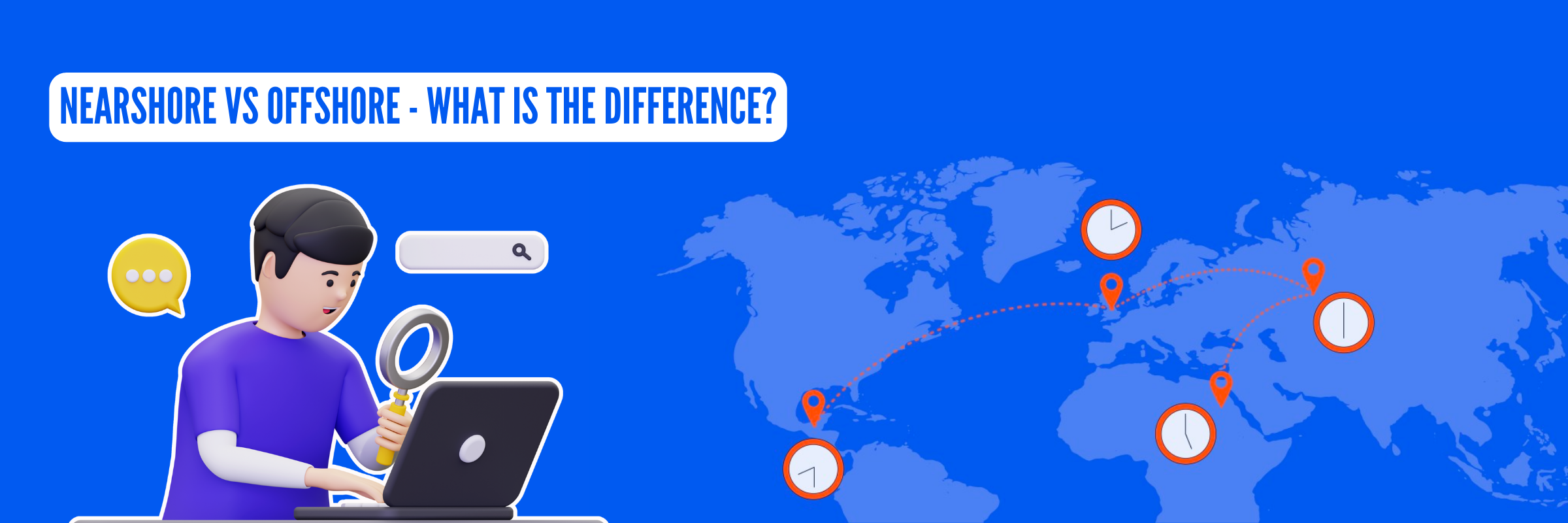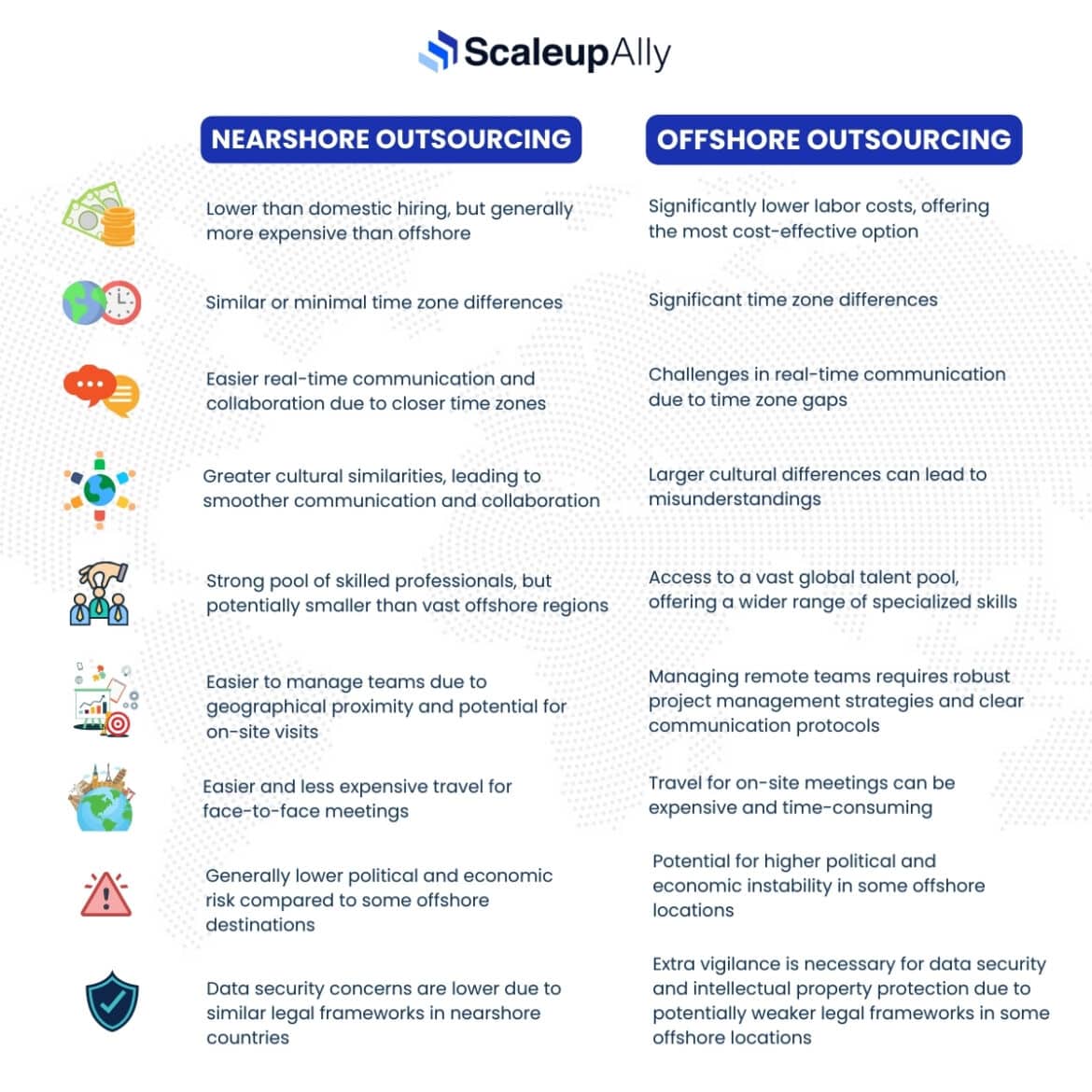
Nearshore Vs Offshore: What is the difference?
Pranay Agrawal | June 25, 2024 , 12 min read
Table Of Content
You’re ready to take your business global, but hiring more people locally isn’t an option. Outsourcing could be the solution, but you’re faced with many choices: nearshore or offshore? Both can save money, but which one is best for your project? Don’t worry! This blog post will clear up the confusion and help you choose the right outsourcing path.
We’ll explore the pros and cons of nearshore vs offshore development, including time zones, cultural differences, communication, and costs. By the end, you’ll know how to make a smart decision that helps your business grow.
Key Takeaways
- Businesses gain flexibility by choosing between nearshore convenience and offshore cost-effectiveness, aligning outsourcing strategies with their operational goals.
- Nearshore outsourcing ensures cultural compatibility and time zone alignment, while offshore options provide access to global expertise and diverse skills.
- Companies can benefit from reduced communication barriers in nearshore models and leverage 24/7 productivity cycles through offshore operations.
- Offshore outsourcing delivers significant cost savings, while nearshore models strike a balance by offering efficiency with easier project management.
- Both nearshore and offshore outsourcing models enable scalability, giving organizations the agility to expand resources quickly without long-term overheads.
What is Nearshore Outsourcing?
Nearshore outsourcing is when a company hires an external organization located in a nearby or neighbouring country to handle certain business tasks or services. The goal is to leverage geographical proximity to benefit from similar time zones, cultural similarities, and easier travel compared to offshore outsourcing (which involves working with a more distant country).
Pros of Nearshore Outsourcing
Nearshore outsourcing offers a compelling alternative to traditional offshore models. Here’s why companies are increasingly choosing to partner with providers in neighbouring countries:
- Cost Savings: While not always as cheap as offshore, nearshore options often provide significant labour cost reductions compared to domestic hiring.
- Time Zone Alignment: Working with a team in a similar time zone fosters smoother communication, collaboration, and faster project turnaround. Imagine real-time meetings and quick clarifications without late-night emails!
- Geographical Proximity: The physical closeness allows for easier travel and face-to-face meetings when necessary. This can be particularly beneficial for complex projects or for building strong working relationships.
- Cultural Similarities: Sharing a similar cultural background can lead to a better understanding of communication styles, work ethics, and business practices. This reduces misunderstandings and fosters a more efficient partnership.
- Stronger Talent Pool: Nearshore locations may offer a deep pool of skilled professionals at a more competitive price point than your domestic market. This allows you to access specialized talent you might struggle to find locally.
- Reduced Risk: Political and economic stability are often higher in nearshore countries compared to some offshore destinations. This can provide greater peace of mind regarding business continuity and data security.
Using nearshore outsourcing, businesses can save money, find skilled workers, and grow faster.
Cons of Nearshore Outsourcing
While nearshore outsourcing has many benefits, it has its drawbacks. Here are some potential challenges to consider:
- Limited Talent Pool Compared to Offshore: The talent pool in nearshore locations might be smaller than in vast offshore regions like Asia. This could limit your options for highly specialized skill sets.
- Higher Costs Than Offshore: Nearshore options typically cost more than some offshore destinations. While still potentially cost-effective compared to domestic hiring, the cost savings might be less significant.
- Hidden Costs: Travel expenses for on-site meetings, legal and regulatory compliance fees, and additional project management needs can add up, eroding the initial cost-saving perception.
- Potential Quality Concerns: Differences in work standards and quality control measures between your company and the nearshore provider could lead to unexpected issues during the project.
- Cultural Nuances Still Exist: Even with cultural similarities, communication styles, and work approaches can differ. Careful communication strategies are necessary to bridge these gaps.
- Intellectual Property Risks: Data security and intellectual property protection may require extra vigilance when working with nearshore partners, depending on the location’s legal framework.
By weighing these potential drawbacks against the benefits, you can make a more informed decision about whether nearshore outsourcing aligns with your specific project needs and risk tolerance.
Now that we’ve looked at the pros and cons of nearshore outsourcing, let’s discuss offshore outsourcing.
Also Read: Differences Between Outsourcing and Offshoring

What is Offshore Outsourcing?
Offshore outsourcing is when a company hires an external organization located in a distant country to perform certain business tasks or services. This strategy is often used to reduce costs, access specialized skills, and increase efficiency.
Pros of Offshore Outsourcing
Offshore outsourcing, venturing beyond your borders for service providers, offers potential benefits for businesses seeking to optimize their operations. Here’s a closer look at the advantages that make this approach so attractive:
- Cost Savings: The primary draw for many companies is the significant reduction in labour costs. Offshore locations often have wages that are considerably lower than your domestic market, leading to substantial cost savings on projects or ongoing tasks.
- Global Talent Pool: The vast talent pool available in offshore destinations is another major advantage. You can access a wider range of specialized skills and expertise that might be difficult or expensive to find locally. This allows you to build a high-performing team with the specific skill set needed for your project.
- 24/7 Operations: The time zone difference can work to your advantage. By outsourcing tasks to an offshore team operating in a different time zone, you can create a near-around-the-clock work cycle. This can significantly improve your responsiveness to customers, meet tight deadlines, or even offer extended support hours.
- Scalability and Flexibility: Offshore providers often offer flexible engagement models. This allows you to easily scale your workforce up or down based on project needs. You can access additional resources quickly during peak periods or adjust team size as project requirements evolve.
- Focus on Core Business: Outsourcing frees up your internal resources to focus on your core business competencies. This allows your in-house team to dedicate their time and expertise to the activities that generate the most value for your company.
While offshore outsourcing presents a compelling case for cost savings and talent access, it’s important to be aware of the potential challenges as well which we will examine next.
Cons of Offshore Outsourcing
While offshore outsourcing can save money and provide access to global talent, it also comes with its own set of challenges. Here’s a look at some potential drawbacks to keep in mind before you decide to outsource overseas:
- Communication Barriers: Significant time zone differences can make real-time communication and collaboration difficult. Delays in responses, misunderstandings due to accents or unclear communication, and cultural differences can all lead to project delays and frustrations.
- Cultural Differences: Working with a team from a vastly different culture can lead to misinterpretations in communication styles, work ethic, and business practices. Establishing clear expectations upfront and maintaining open communication throughout the project is crucial to bridge these gaps.
- Intellectual Property Concerns: Data security and intellectual property (IP) protection require extra vigilance when working with offshore partners. Unequal legal frameworks in some countries can pose a risk. Strong legal contracts, secure communication channels, and clear ownership clauses are essential to safeguard your confidential information.
- Management Challenges: Effectively managing a remote team located overseas can be complex. Difficulties in monitoring progress, providing clear instructions, and building a strong team rapport necessitate project management strategies and clear communication protocols.
- Quality Control Issues: Quality control standards can vary significantly between countries. Without a well-defined quality assurance process in place, you might face issues with deliverables not meeting your expectations. This can lead to rework, delays, and potential financial losses.
- Hidden Costs: While upfront labor costs might be lower, additional expenses like travel for on-site meetings, legal and regulatory compliance fees, and potential communication technology needs can add up, eroding the initial cost-saving perception.
By thinking about the possible downsides and the benefits, you can decide if offshore outsourcing is right for your business and if it matches your comfort level with taking risks.
Comparative Analysis: Nearshore vs. Offshore Outsourcing
Choosing between nearshore vs offshore outsourcing can be a strategic decision for your business. Here’s a breakdown of key factors to consider:
| Factor | Nearshore Outsourcing | Offshore Outsourcing |
|---|---|---|
| Cost | Lower than domestic, but higher than offshore | Significantly lower, most cost-effective option |
| Time Zone | Minimal differences, easier collaboration | Significant differences, challenging communication |
| Communication | Real-time communication is easier | Time zone gaps create challenges |
| Cultural Affinity | Similar cultures, fewer misunderstandings | Cultural differences can lead to miscommunication |
| Talent Pool | Skilled professionals, but smaller pool | Vast global pool with diverse skills |
| Management | Easier to manage, proximity allows on-site visits | Requires strong remote management strategies |
| Travel | Cheaper, easier for face-to-face meetings | Expensive and time-consuming travel |
| Risk | Lower political/economic risk | Higher risk in some regions |
| Data Security | Stronger legal frameworks, lower concerns | Weaker legal frameworks, higher security risks |
In summary:
- Nearshore outsourcing offers a good balance between cost savings, communication ease, and cultural similarities. It’s ideal for projects requiring frequent collaboration and where cultural understanding is important.
- Offshore outsourcing provides the most significant cost savings and access to a wider talent pool. However, communication challenges, cultural differences, and potential data security risks require careful consideration.
Nearshore vs Offshore: What works best for your business?
The decision between nearshore vs offshore outsourcing hinges on several key factors specific to your business needs and project goals. Here’s a roadmap to guide you through this critical choice:
1. Project Budget
- Nearshore: A good fit if you have a moderate budget and cost savings are important, but not the top priority.
- Offshore: Ideal for tighter budgets where significant cost savings are essential.
2. Required Skill Set
- Nearshore: A strong option if you need a specialized skill set that might be more readily available in a nearshore location with cultural and educational similarities to your domestic market.
- Offshore: Excellent choice if you require a broader range of specialized skills or a very unique talent pool that might be more abundant in offshore regions.
3. Communication Needs
- Nearshore: Favored if real-time communication and collaboration are crucial for your project. Similar time zones and potentially shared cultural nuances can facilitate smoother communication.
- Offshore: Consider this option if real-time communication is less critical and you have robust project management strategies to bridge time zone gaps.
4. Project Complexity
- Nearshore: Advantageous for complex projects that require frequent collaboration and ongoing communication. Geographical proximity allows for easier in-person meetings and fosters stronger team relationships.
- Offshore: Can be suitable for less complex, well-defined projects where clear communication protocols and established processes are in place.
5. Data Security and Intellectual Property (IP)
- Nearshore: Generally lower risk due to similar legal frameworks in nearshore countries. Data security concerns might be less pronounced.
- Offshore: Requires extra vigilance, especially in locations with weaker legal frameworks. Strong legal contracts and secure communication channels are essential to protect your confidential information.
6. Risk Tolerance
- Nearshore: Generally lower political and economic risk compared to some offshore destinations.
- Offshore: Consider your risk tolerance for potential political or economic instability in some offshore locations.
There’s no one-size-fits-all answer. Carefully weigh these factors against your specific project requirements and risk tolerance to determine whether nearshore or offshore outsourcing aligns best with your business goals.
How ScaleupAlly Can Help?
Scaling your business can be challenging, but ScaleupAlly makes the process easier and more efficient. Here’s how we can assist you:
- Expert Guidance: Our experts provide tailored advice to help you navigate the complexities of scaling.
- Outsourcing Solutions: We deliver reliable offshore development center services, that streamline operations, reduce costs and let you focus on what matters most.
- Talent Acquisition: Access a global pool of skilled professionals in various fields, from IT to finance.
- Efficient Processes: We streamline your operations with best practices and cutting-edge technologies, boosting efficiency.
- Quality Assurance: We ensure outsourced tasks meet high-quality standards through regular monitoring and feedback.
- Risk Management: We identify and mitigate outsourcing risks, including time zone differences, cultural nuances, and data security concerns.
- Continuous Support: Our support extends beyond setup, offering ongoing assistance to keep your business thriving.
ScaleupAlly is your trusted partner in growth, handling the complexities of scaling so you can drive your business forward.
Conclusion
Choosing the right outsourcing partner depends on what your business specifically needs. Think about your budget, the skills needed, how you will communicate, how complex the project is, how secure your data needs to be, and how much risk you can handle. By considering these factors, you can find an outsourcing partner that will help your business grow.
Don’t hesitate to try a mix of nearshore and offshore resources! This hybrid approach can give you the best of both worlds.
Making a well-informed decision can help you get the most out of outsourcing – saving money, gaining access to skilled workers, and reaching your business goals.
Frequently Asked Questions (FAQs)
Q: What is the main difference between nearshore and offshore outsourcing?
It boils down to location! Nearshore partners are in nearby countries with similar time zones, while offshore partners are farther away with significant time zone differences.
Q: How do I decide between nearshore and offshore outsourcing for my business?
Consider your project budget, needed skills, communication needs, complexity, and risk tolerance. Nearshore is ideal for frequent collaboration and cultural understanding, while offshore offers the most cost savings and a wider talent pool.
Q: Are there any trends in outsourcing for 2024 that I should be aware of?
Yes! Some of the trends in the outsourcing industry are growing focus on cybersecurity, with clients prioritizing data security in outsourcing partnerships. Additionally, a hybrid approach combining nearshore and offshore resources is gaining traction.
Q: What should I look for when selecting an outsourcing partner?
Look for a partner with expertise in your industry, a strong track record, clear communication practices, and robust security measures in place.
Q: How can I manage the transition to an outsourcing model effectively?
Clear communication, setting expectations, and establishing well-defined processes are crucial. Consider a pilot project to ensure a smooth transition before full-scale outsourcing.
Related Blogs

Top 20 Emerging Technologies of 2026
Discover the top 20 emerging technologies of 2026. Explore which innovations are driving change across healthcare, finance, manufacturing, and other crucial industries.
ScaleupAlly Team
Dec 16 ,
9 min read

IT Outsourcing Costs Explained: Global Rates, Key Influencers & Cost-Saving Tips
Discover what IT outsourcing costs include, key pricing factors, hidden fees, regional rates, and how to pick a cost-effective outsourcing partner.
Pranay Agrawal
Nov 29 ,
13 min read

IT Consulting Rates Per Hour in 2025: Country & Industry Wise
Discover IT consulting rates broken down by experience, specialization, industry, and country. Plan your budget and find the right IT talent for your business needs.
Pranay Agrawal
Nov 25 ,
13 min read


